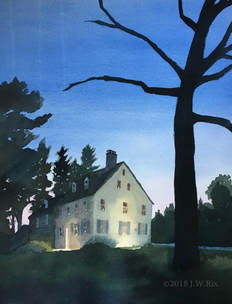 Wall House Nocturne, 22 x 18 in. Wall House Nocturne, 22 x 18 in. At the reception for the Artist in Residence Exhibition last Sunday, the most common question viewers asked me was "What is a nocturne?" (This was second only to, "What do you mean by Ghost Chickens?" See my post from 12/7/17 for the answer to that one.) Simply stated, nocturne paintings capture something about the twilight or night time. It was already known as a musical term when James Abbott McNeill Whistler first used it in the titles for several paintings in the 1870s. Nocturnes aren't that common and I have 5 of them in the show right now at the Cheltenham Art Center. I suppose that might strike some as strange. What caught my eye during an evening pass of the Wall House in my car, is the window lights. They almost make this old house seem inhabited in the gloaming. This was the last painting I completed for this year-long residency at the Cheltenham Center for the Arts. Personally, it marks the end of a body of work where I worked hard to keep focused, and now I look forward to a little experimentation and outdoor adventure. Watch out for the plein air cyclist!
0 Comments
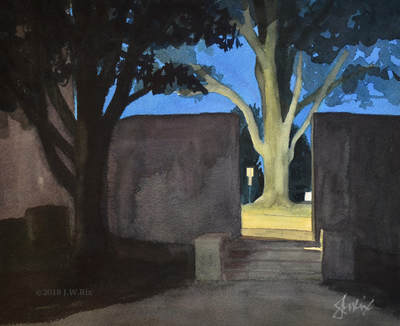 Curtis Hall Nocturne Curtis Hall Nocturne This tree is the same American Elm featured in my last post, except at night. Which brings me to the theme that emerged in my work for this artist residency... night and day. There is something I find very pleasing in the way that the dark layers of paint allow the lights to shine. I find it hard to believe that the end of my residency at the Cheltenham Center for the Arts is upon me. The studio, the community, the commute along the creek... pretty soon will not be a part of my daily routine. I am so grateful for the support I have received in building this body of work! All of the paintings feature aspects of my hometown, both during the day and at night. I hope you will have a chance to see the exhibition between May 20 and June 12. The reception is on Sunday, May 20th from 2pm - 4pm. 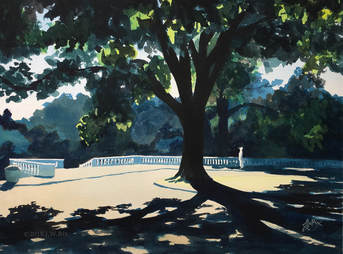 Mary Louise Curtis at Curtis Arboretum Mary Louise Curtis at Curtis Arboretum It makes sense to me now why Mary Louise Curtis left the music room of her family home standing when she donated Curtis Arboretum to Cheltenham Township. Music was a passion of hers. Not only did she play the piano and marry the famous violinist Efrem Zimbalist, she also founded the Settlement Music School and the Curtis Institute of Music. This view of Curtis Arboretum shows the original balustrade that was once just outside the doors of the great house of the Lyndon Estate, built by Mary Louise's father, publishing magnate Cyrus H. K. Curtis. Mary Louise grew up in that house. I painted her (as an adult) under the great elm tree planted at the heart of the old house. It was after her father died that she demolished most of the house and donated the estate for public use. Today, I wonder if the ornate moldings of the remaining music room (known as Curtis Hall) inspire the attendees of the township meetings that take place there. I know they inspired me on a most important day in my life...my husband and I rented the hall for our wedding reception 17 years ago. It seems fitting that I learned about the life of Mary Louise Curtis in the course of my research for the body of work I am creating as the resident painter at the Cheltenham Center for the Arts this year. I have been so grateful for this place I have known most of my life, now I know who to thank for it. Click here if you would like to see a portrait of Mary Louise Curtis by Norman Rockwell. 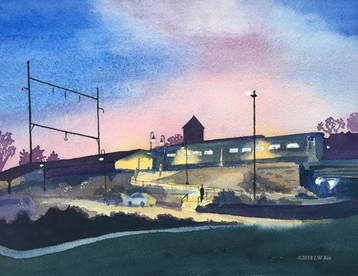 Elkins Park Train Station at Dusk Elkins Park Train Station at Dusk Including figures in a landscape painting is a challenge. Why include them? Scale and interest. Do I include them in my landscapes? I'm working on it. Look, there are a few in this painting! Howard Watson first brought this concept onto my radar last year. It was a profound moment when I realized how the narrative of a work could suddenly become so much more. For example, instead of just showing a spring house, I could tell a history that there used to be a chicken coop in the upper part of the structure by including some chickens. See Ghost Chickens. In this painting here, I was first interested in how the light creates the space at this time of day. However, when I added those commuters who are coming off the train and either walking home or going to one of those cars...there is a whole new story. In fact, is that you in my painting? Maybe. I'm currently attending a short course at the Wayne Art Center with Mick McAndrews on this art of putting figures in a landscape. Mick is a great guide. (See his amazing work here.) So, I feel there will be more figures to come in my work. Be careful, if you haven't already...you might find your way into one of my paintings. 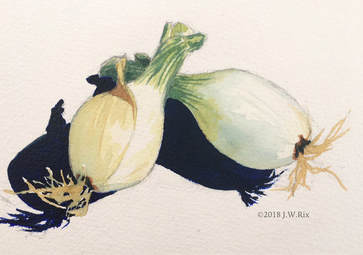 Farm Onions, watercolor, 5 x 7 inches Farm Onions, watercolor, 5 x 7 inches The last in a trio of vegetable paintings, I present "Farm Onions" I love how, unlike most onions that I buy, you can see the part of the plant that grows above the soil. The painting challenge here is in the subtle study of white... for white objects are rarely actually white. I learned this from my hero John Singer Sargent. When I look at paintings like "Simplon Pass: Reading" done in the Alps in 1911, the multitude of greens, blues, yellows, and grays that create the white drapery stun me. Feast your eyes on it here. 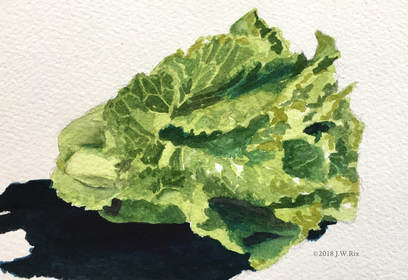 Organic Lettuce Love Organic Lettuce Love Locally grown, organic vegetables inspire me. They feed me both physically and artistically. And, best of all, I know that I am supporting farmers who are on the front lines of improving our sustainability. * I really enjoyed the range of greens in this painting, which are all mixed. The painting begins with a cobalt blue and winsor lemon, continues with a prussian blue and winsor lemon, then ends with Prussian blue and indian yellow. All relatively transparent mixtures. Like several other vegetable paintings I've done in the past year, this head of lettuce came from the Pennypack Farm and Education Center last summer. I've recently prepared for the 2018 growing season by buying into the Lancaster Farm Fresh Co-op. I'm looking forward to the variety and quality of produce they grow and I plan to continue this series of paintings. :) *Notably, organic farmers are supporting our declining bee populations by not using neonicotinoid pesticides, or seeds treated by this noxious chemical which has become too common in the conventional agricultural market. Organic veggies support bees, and who doesn't love bees? 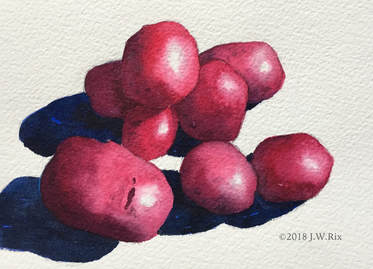 Red Potatoes, 5 x 7 inches Red Potatoes, 5 x 7 inches Upon reflection, I see a great metaphor in this watercolor study. Not only are these beautiful potatoes a product of organic farming practices at Pennypack Farm and Education Center last season (so delicious!), they refer to a common phrase. I first approach that phrase in my quest to simplify. It acts as a mantra to avoid letting the small stuff block my sight of what's really important along the lines of Don't Sweat the Small Stuff by Richard Carlson. However, after finding a quote by Charles Dudley Warner who while gardening in 1870 wrote, "What small potatoes we all are, compared with what we might be!" I feel like my eyes have been opened. His view in this quote is that we often stunt our growth because we "don't plow deep enough." (Thank you Project Guttenberg, where I found Warner's book My Summer in the Garden.) I am inspired by a new mandate to nurture my small potatoes into big potatoes by taking the time to dig deeper into the earth. Stay tuned for next year's crop! 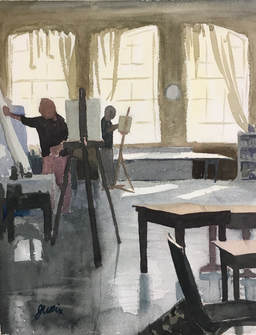 Thursday Class at CCA Thursday Class at CCA Since I've been indoors painting this winter, I've been inspired by the physical place where I have a studio residency. The tall ceilings, the large windows, the open space and all of the early 20th century details of the old schoolhouse are great, but even better is getting to know the artists who have been coming here for years, sometimes decades. So last week I spent a little time with Colleen Hammond's Thursday open studio painting class, a very welcoming group of artists who work hard and support each other. Everyone there has an intriguing story. I much prefer to work from life because sitting with my subject has great meaning to me. The experience evokes a deeper emotional reaction in me. I aim to capture the feeling of the light as well as the energy of the place. I am grateful to my hosts at the Cheltenham Center for the Arts. It's been around quite awhile...may it continue to be a sanctuary for art making for a long time to come! 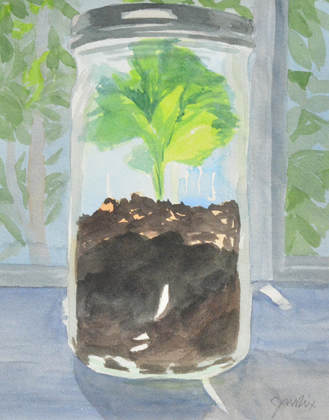 Feathered Asparagus In Memorandum Feathered Asparagus In Memorandum Have I mentioned I love terrariums? Something about the way they contain earth, air, light, water and plant life is so elemental. As a microcosm of an ecosystem, the relationship between entities reads like a metaphor for an environmental theory of well being. When I observe them, it is like they are talking to me. And yes, I've come into the habit of naming my terrariums. This terrarium, I made three years ago. It is one that unfortunately didn't make it . Old friend- I wish we had more time together. Thank you for all that you have taught me. I wish I had been better able to fit your needs. I am grateful that I made this painting of you during your prime as a way to remember you and to share the story of your brilliance with others. 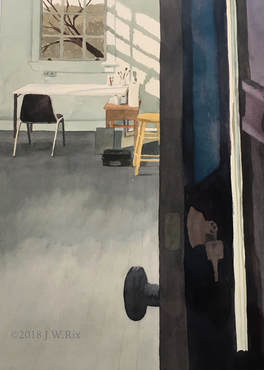 Painting Residency Studio at the Cheltenham Center for the Arts Painting Residency Studio at the Cheltenham Center for the Arts It worked! Giving myself more time between posts helped me to work larger.. This image is a detail of a full-sheet, 30 by 22 inch painting that is nearly finished. Working larger certainly brings technical challenges, but I am excited about how the larger paintings will present themselves to in-person viewers at the Residency Exhibition in May. My studio, a space allowed to me this year through the painting residency, is currently in a corner of the second floor of the George K. Heller School, commonly known as the Cheltenham Center for the Arts on Ashbourne Road. While this section of the building with its tall ceilings and massive windows was "recently" added in 1906, the original school on this site, named the Milltown School, opened its doors as the very first public school in Montgomery County in 1795. In 1883, the original one-story George K. Heller School was built to replace the Milltown School. It was expanded in 1893 and in 1906 to create the building that became the Cheltenham Art Center in 1953. I have to say, it's pretty cool working in a space that is listed on the National Register of Historic Places! |
Little Bee:
|
